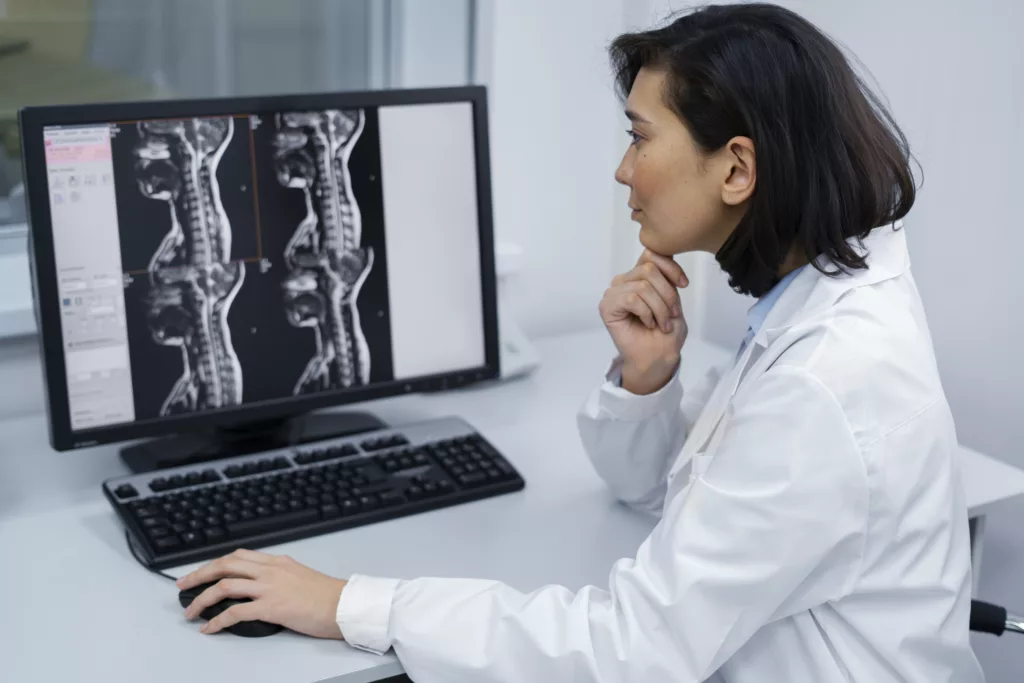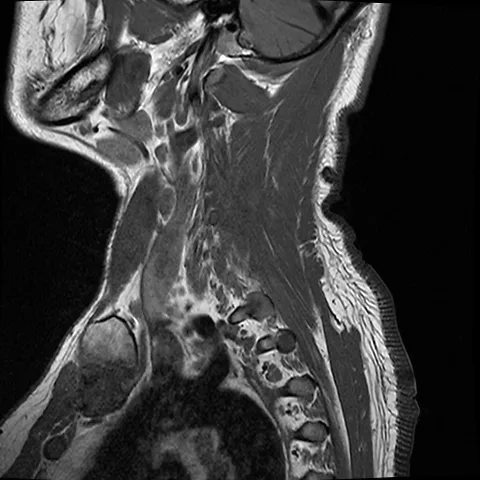Cervical spondylosis with myelopathy (CSM) is a type of chronic degenerative disease that was first identified by Brain in 1952 11. Northover, J.R., Wild, J.B., Braybrooke, J. and Blanco, J., 2012. The epidemiology of cervical spondylotic myelopathy. Skeletal radiology, 41, pp.1543-1546. .
This condition most commonly affects males during their 7th decade of life 25. Afifi, T., Zektser, K. and Raghunandan, A., 2022. Cervical Myelopathy. In A Case-Based Approach to Neck Pain: A Pocket Guide to Pathology, Diagnosis, and Management (pp. 65-93). Cham: Springer International Publishing. . Overall cervical spondylosis with myelopathy is a common cause of spinal cord dysfunction in elderly patients (> 55 years of age). It can also affect younger children with narrower birth canals. This condition usually presents as multilevel cervical spondylosis. The onset of the disease is insidious, and the symptoms are subtle and variable during the early stages and are often present before the presentation of the disease.
What is Cervical Spondylosis with Myelopathy?
Cervical refers to the part of the spinal cord that makes up the neck (C1 – C7), spondylosis refers to the degeneration of the spinal cord, and myelopathy refers to damage to the spinal cord. Therefore cervical spondylosis with myelopathy can be defined as a degenerative disease that damages the cervical spinal cord. The most common sites it affects are the C5-6 disc and the C6-7 disc.
Signs and Symptoms
CSM is a slow disease that progresses over time, and the symptoms imitate the same pattern. Patients with CMS can present with a variety of different symptoms, such as:
Numbness or Tingling Sensation
This is often felt in fingers, hands, arms, or legs. The nerves supplying this region arise from the brachial plexus, which has its roots from C5 to T1.
Atrophy of Muscles
Weakness in the muscles of hands, shoulders, or arms. Patients will often complain of having difficulty grasping or holding objects. Lhermitte’s sign (having a sensation of an electric shock down the arm after neck flexion) can also be present.
Unsteady Gait or Spastic Gait
Patients may complain of having difficulty in walking and coordination. Cervical spondylosis with myelopathy can also present with vertigo (spinning of the head) and tinnitus (ringing of the ears), this interferes with the normal balance and causes difficulty in walking.
Ataxia
There is a decline or loss of fine motor skills such as buttoning clothes, tying shoelaces, feeding, handwriting, or picking small objects.
Neck Stiffness
This is often the main symptom of CSM. It can be unilateral or bilateral. Patients complain of experiencing pain on moving their necks. This pain can also radiate toward the shoulder and subscapular areas.
What Causes Cervical Spondylosis with Myelopathy?
CSM occurs due to changes in the spinal cord’s ligaments, discs, and bones. These changes put pressure on the spinal cord resulting in CSM. Symptoms typically appear when the spinal cord is reduced by 30% 3Young, W.F., 2000. Cervical spondylotic myelopathy: a common cause of spinal cord dysfunction in older persons. American family physician, 62(5), pp.1064-1070.. The pathophysiology behind CSM occurs in three stages;
Static Mechanical Factors
As a person ages, their intervertebral discs also age, and with age, the discs begin to degenerate by losing water content and drying out. This makes the discs lose their thickness and become stiff, thus causing the vertebrae to move closer to each other than they were. The collapsed discs also stimulate the body to form bone spurs around the disc to provide strength. This causes further stiffening of the spine and narrowing of the spinal canal, resulting in compression of the spinal cord. Increased bone growth can also stiffen the ligamentum flavum, which contributes further to the compression of the spinal cord.
Dynamic Mechanical Factors
This occurs on the principle that normal movement of the cervical spine can worsen the damage caused by the compression of static mechanical factors. Extending the neck (moving it backward) can cause the stiffened ligamentum flavum to buckle into the spinal cord, decreasing the space in the spinal canal.
Spinal Cord Ischemia
In the later stages of CSM, the cervical spinal cord can suffer from ischemia (cell death). Although the exact mechanism through which this happens is still not completely understood.
Diagnosis of Cervical Spondylosis with Myelopathy
Cervical spondylosis with myelopathy produces symptoms similar to other conditions like muscle spasm, slipped disc or even tendonitis. 44. McCormick, J.R., Sama, A.J., Schiller, N.C., Butler, A.J. and Donnally, C.J., 2020. Cervical spondylotic myelopathy: a guide to diagnosis and management. The Journal of the American Board of Family Medicine, 33(2), pp.303-313. . After taking a thorough history from the patient and conducting a physical examination to evaluate the sensory and motor capabilities, the doctor can order various tests. A cervical X-ray can tell if there is a problem with the spine, but it’s not a conclusive test. CT scan and MRI can provide the basis for a definitive diagnosis:
Post-Myelography Computed Tomography (myelo-CT)
This is a type of advanced X-ray. To perform the CT, the doctor will inject radio-opaque contrast material into the patient’s spinal fluid with the help of a lumbar puncture. The interior of the spinal canal will then be observed. If CSM is present, the herniated discs or bone spurs compressing the spinal cord will present as indentations of the spinal fluid sac in the x-ray, thus confirming the diagnosis.

Magnetic Resonance Imaging (MRI) Scan
MRI is the gold standard test for examining the interior of the spinal canal, including the spinal cord, intervertebral discs, nerve roots, and ligaments. The procedure allows the doctor to thoroughly examine the interior of the cervical canal by producing high-resolution images, thus aiding towards a confirmatory diagnosis.

Treatment of Cervical Spondylosis with Myelopathy
Cervical spondylosis treatment depends on the severity of the disease. The treatment aims to provide pain relief, help the patient stay compatible with life and maintain maximum daily activities and prevent further damage to the spinal cord and its nerve fibers. To achieve these goals, the treatment can be provided in three ways:
Medications
Non-Steroidal Anti-Inflammatory Drugs
NSAIDs, for example, naproxen sodium and ibuprofen, are recommended as the first-line treatment to relieve pain associated with CSM. NSAIDs inhibit the COX enzyme that produces prostaglandin which increases inflammation.
Corticosteroids
The doctor may advise a steroid injection or a short course of oral corticosteroids such as prednisone to treat more severe pain and reduce inflammation as they suppress the genes involved in inflammatory pathway.
Muscle Relaxants
Patients who experience spasms in their necks can take muscle relaxants such as cyclobenzaprine, as they decrease the muscle tone and tension through blocking the neuromuscular junction.
Anti-Depressants and Anti-Seizures
These drugs are also advised to relieve pain but are not recommended as first-line treatment.
Physical Therapy
Physical therapists can help the patient perform several cervical exercises. These exercises help strengthen and stretch the neck and shoulder muscles and are one of the best methods to treat neck stiffness and pain. Traction therapy which uses force to stretch out muscles can also benefit people who have cervical spondylosis.
Laminectomy
Laminectomy is a surgical procedure that is done if the symptoms of the patient persist and fail to improve with medication and physical therapy. The surgery aims to create more space for the spinal cord and nerve roots to decrease the compression. This can include the removal of bone spurs and herniated discs; however, it does present its risks53. Yin, M., Xu, C., Ma, J., Ye, J. and Mo, W., 2021. Bibliometric analysis and visualization of current research trends in treating cervical spondylotic myelopathy. Global spine journal, 11(6), pp.988-998. .
What are the Risk Factors of Cervical for CSM
The biggest risk factor contributing to cervical and lumbar spondylosis is aging. Other risk factors include:
- Short height
- Higher BMI
- Less or no physical activity
- Injury or trauma to the neck
- Smoking
- Diseases such as Down Syndrome
- Hereditary factors
- Awkward positioning of the neck for long hours persistently
- Male gender
Conclusion
Cervical spondylosis with myelopathy is the most common type of myelopathy that is seen in senile individuals. It is a type of degenerative chronic disease that affects the intervertebral discs, facet joints, vertebrae, and ligaments of the cervical spine. Patients can present with various symptoms, such as pain, stiffness, sensory loss, or motor loss in the limbs, shoulders, and neck region. It is important to make a confirmatory diagnosis of a patient with CSM because the symptoms mimic several different diseases. Several imaging tests can help the doctor make a confirmatory diagnosis. Treatment of CSM depends on the severity of the disease.
Refrences
- 11. Northover, J.R., Wild, J.B., Braybrooke, J. and Blanco, J., 2012. The epidemiology of cervical spondylotic myelopathy. Skeletal radiology, 41, pp.1543-1546.
- 25. Afifi, T., Zektser, K. and Raghunandan, A., 2022. Cervical Myelopathy. In A Case-Based Approach to Neck Pain: A Pocket Guide to Pathology, Diagnosis, and Management (pp. 65-93). Cham: Springer International Publishing.
- 3Young, W.F., 2000. Cervical spondylotic myelopathy: a common cause of spinal cord dysfunction in older persons. American family physician, 62(5), pp.1064-1070.
- 44. McCormick, J.R., Sama, A.J., Schiller, N.C., Butler, A.J. and Donnally, C.J., 2020. Cervical spondylotic myelopathy: a guide to diagnosis and management. The Journal of the American Board of Family Medicine, 33(2), pp.303-313.
- 53. Yin, M., Xu, C., Ma, J., Ye, J. and Mo, W., 2021. Bibliometric analysis and visualization of current research trends in treating cervical spondylotic myelopathy. Global spine journal, 11(6), pp.988-998.

